Search Results for: kagaya
FOOD NETWORK TV CLIPS! SHIBUYA BUTLER CAFE, BUTLERS TEACH JAPANESE GIRLS ENGLISH. KAGAYA: CRAZIEST TOKYO BAR.

Last fall, La Carmina & The Pirates filmed with Food Networks’s “World’s Weirdest Restaurants” for almost a month straight. Oh, the fun we had!
Did you miss out on the TV show? Don’t worry: I’ve uploaded video clips above and on YouTube.
Watch La Carmina and friends explore Tokyo’s wackiest theme restaurants, including Alice in Wonderland, maid cafe, Christon Cafe, monkey waiter tavern, and Zauo fishing boat.
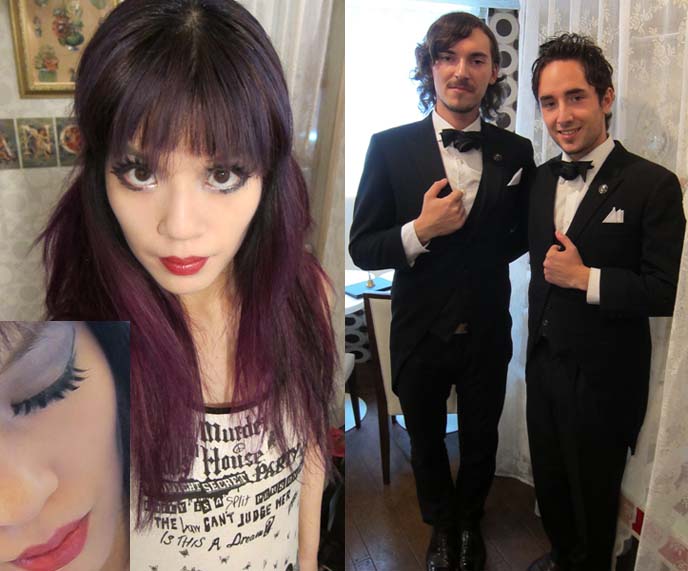 Shibuya Butlers Cafe. All the servers are foreigners, who speak English to help the customers practice.
Shibuya Butlers Cafe. All the servers are foreigners, who speak English to help the customers practice.
ince many Japanese men lack romantic spirit, females come here to feel like Disney heroines. The butlers get down on one knee, and present them with a tiara!
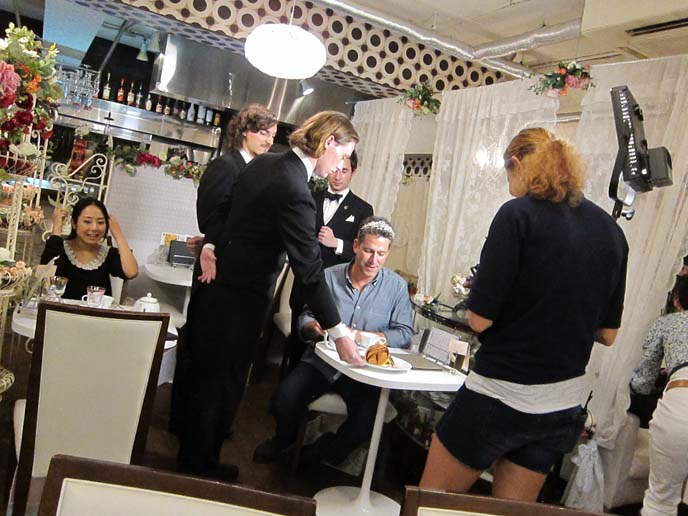
I’m wearing an h.NAOTO dress from Closet Child, and doll-like eyelashes. First Mate Naomi made the drawing of me in the first photo.

More madness from the Food Network TV shoot: giving Bob Blumer a Goth makeover, and visiting the surreal frog-pond experience that is Kagaya.
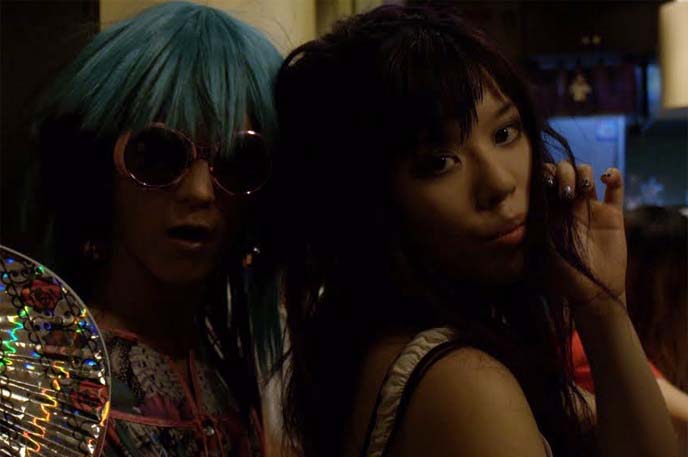
We adore the owner’s spastic performances. Here’s a previous post about Kagaya Tokyo.

Someone’s about to jump out of the closet, wearing a bizarre costume.
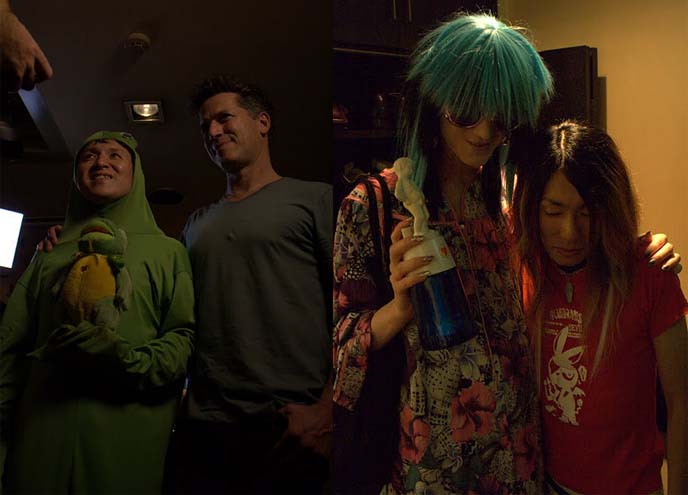
The whiskey squirts out of the statue’s… yeah.

When you order a drink, you can choose a country and Mark will do a bizarre interactive performance. This one is “France.”

Kagaya is possibly my favorite restaurant in the world. The food is delicious: I love the kabocha (pumpkin).
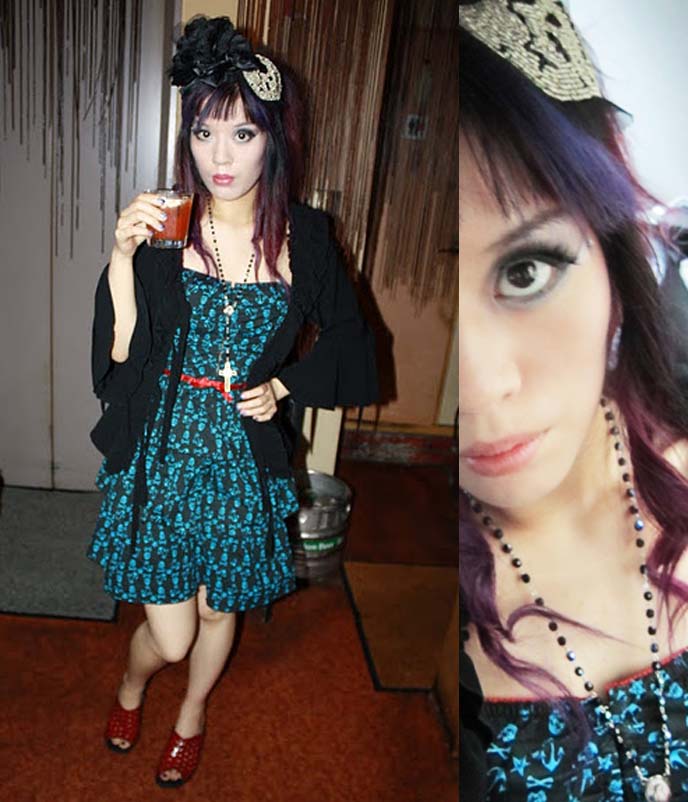
On the other end of the scale… Mayonnaise Kitchen is the most disgusting theme cafe I’ve encountered.
Skull headband: gifted by Soho Hearts (check out the panda necklace I designed with them)
Blue and black dress: gifted by Iron Fist (I love their zombie shoes)
Black frilled Lolita jacket: Angelic Pretty, from Closet Child
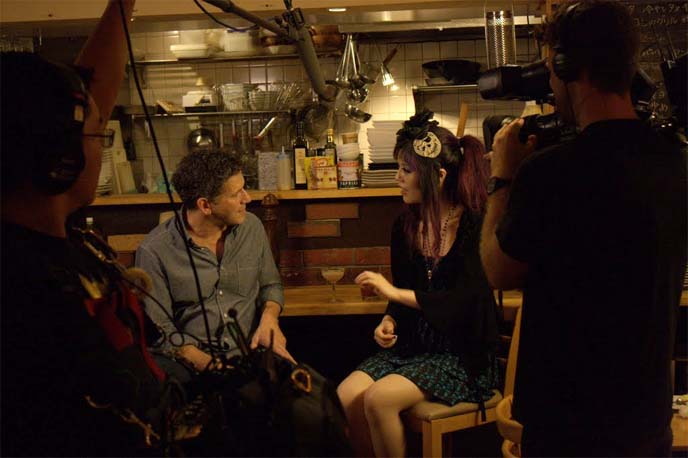
I explain the Japanese love of mayonnaise, especially the Kewpie brand, and how the ingredients and texture are a bit different from the Western version.
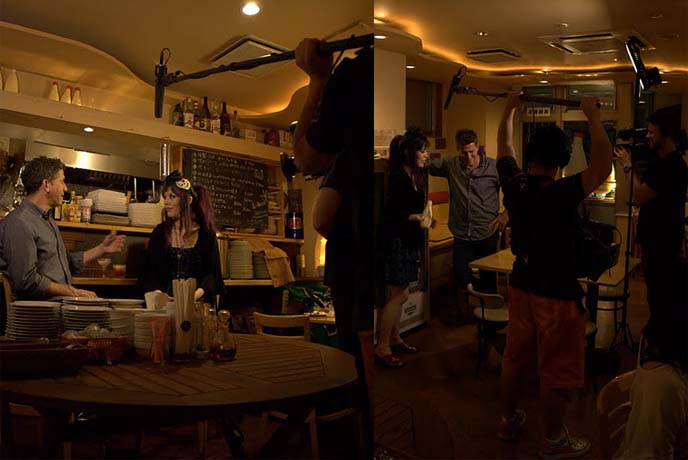
Personally, I don’t get it. Every dish in this restaurant is doused in mayo — blehh.
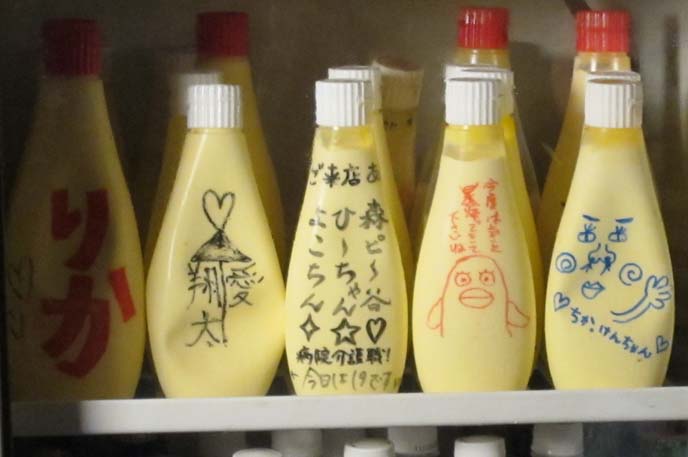
Hardcore customers even have their own personalized bottle.

I also visited Sumire no Tenmado: a doll-like Gothic Lolita café, run by Kokusyoku Sumire (two classical musicians). Tim Burton drew Jack Skellington and left his signature on the wall.
Hungry for more? Want addresses, photos and stories? Check out my book, Crazy Wacky Theme Restaurants: Tokyo.
Did you enjoy watching us on this Food Network TV show? Which cafes did you like best? Please take a minute to see our video clips on YouTube!
❤ Arr! Support us Pirates w/ a Like (below) ❤
SHARE & COMMENT
Visiting teamLab Borderless Digital Mori Museum & Planets Tokyo! For Love & Lemons dress, Hermès Collier de Chien.
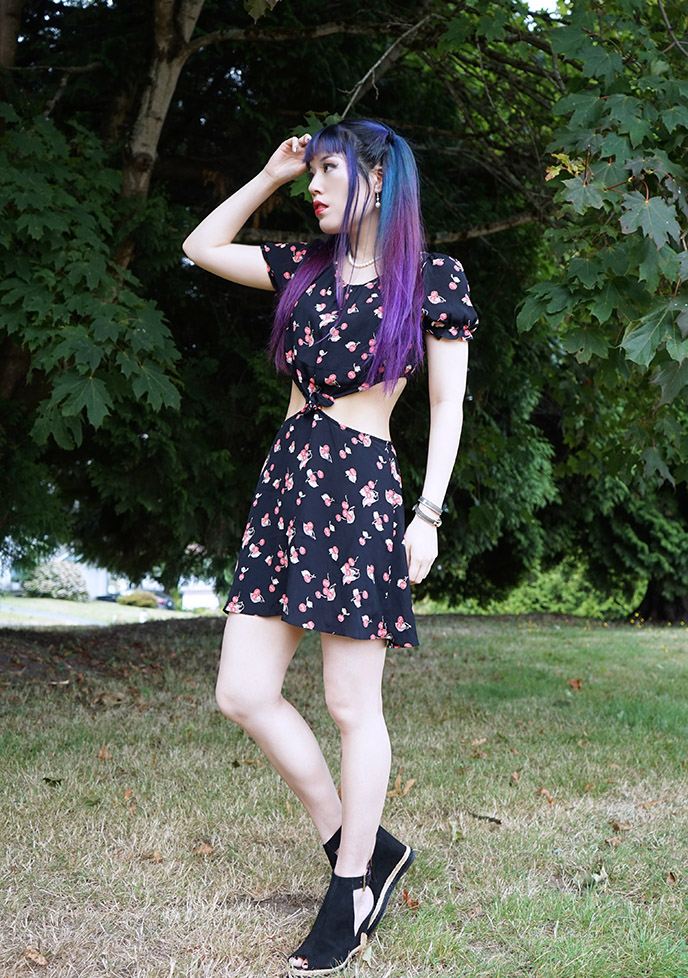
Before I take you inside the Tokyo teamLab museum — I wanted to thank you for the birthday wishes on my Facebook and Instagram! I took these quick outfit photos on August 17, before celebrating with friends.
OOTD: I’m wearing a cherry print mini dress with a cut-out waist by For Love & Lemons, and black platform sandals from Le Babe by Ferca Italy.
If you haven’t heard of For Love and Lemons, I think you’d love the dresses below (click the images to see):

I accessorized with a short pearl necklace from Japan, and here’s the current hair situation.
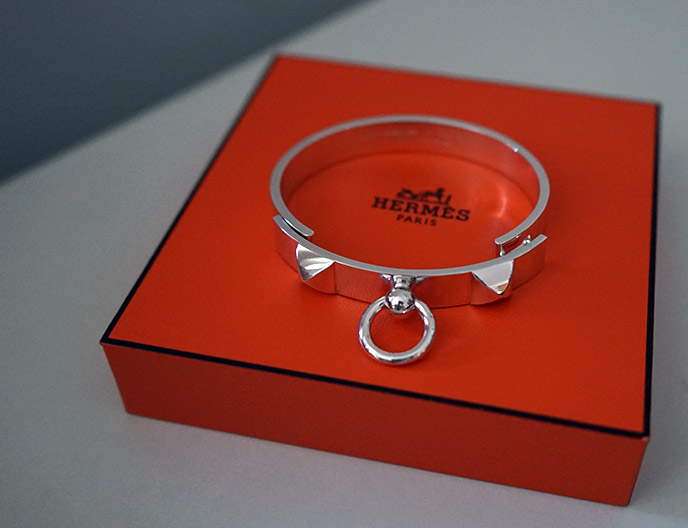
I had a lovely birthday, with plenty of surprises. Still can’t believe I received this fantasy bracelet… a Hermès Collier de Chien.
This is the silver CDC small model hinged cuff (Hermes has various versions with different hardware, leathers, and sizes). The studs and dog collar O-ring give it Gothic BDSM vibes — a perfect fit.

What I wore on my birthday, for a party. This short sleeved For Love & Lemons dress is as summery as I’ll get. The cherry print sundress has a 1990s feel, with revealing cutaway sides and a tie front.

Couldn’t resist taking some closeups of my first Hermès Paris jewelry and the iconic orange gift box. Love the minimalism of this silver collier de chien design (it’ll go with all types of outfits). The Medor pyramid studs and circular ring give the CDC bracelet a Goth punk S&M edginess.

I matched my For Love and Lemons cherries dress with Le Babe peep-toe sandals. See more of my favorite black platform shoes below:
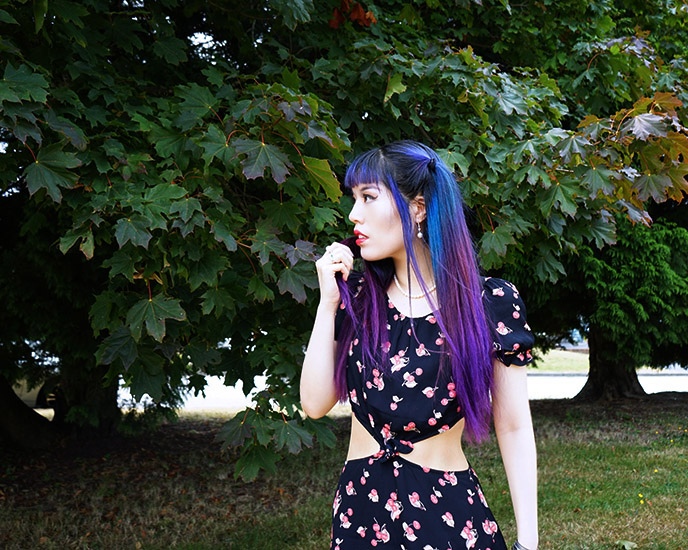
Thank you again for the well-wishes, as another year goes by. Now, let’s segue into my guide to visiting Teamlab, the hottest new museum in Japan.
Every time I visit Tokyo, there’s always something new and wild to discover. On my last visit, my friends and I received a private guided tour of the Digital Mori Museum, by one of its creators!
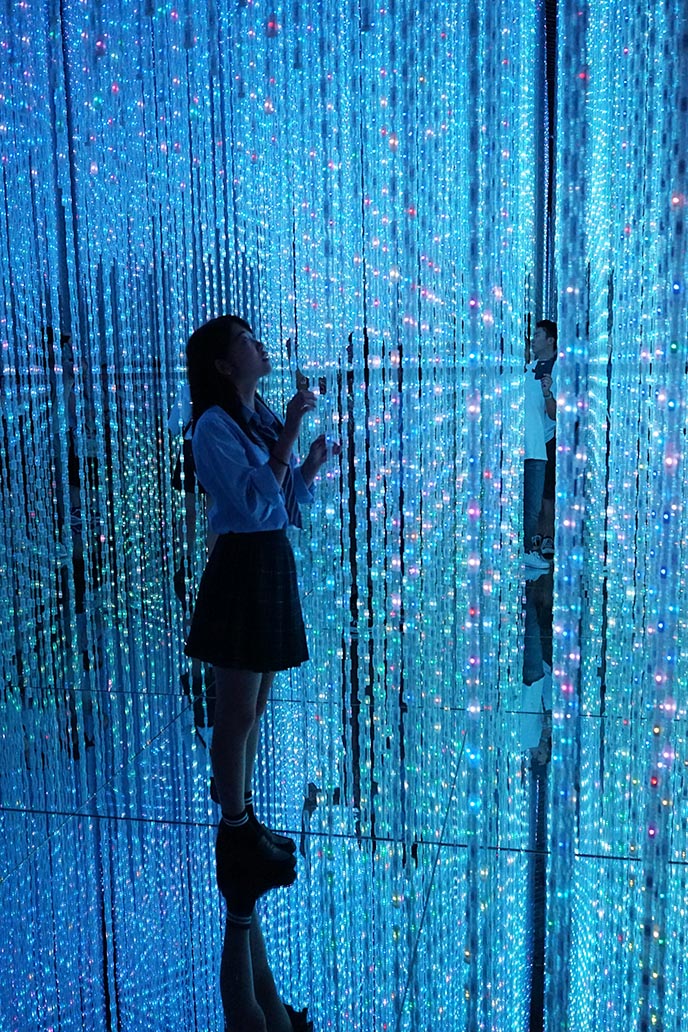
I’m sure you have heard of (or seen scintillating photos) of Tokyo’s recently-opened teamLab Borderless and Planets. These museums push the boundaries of futuristic technologies, and encourage you to interact with art in unexpected ways.
Read on for a full guide to visiting teamLabs Planets and Borderless in Tokyo — including the difference between the two museums, how to get tickets, and more.
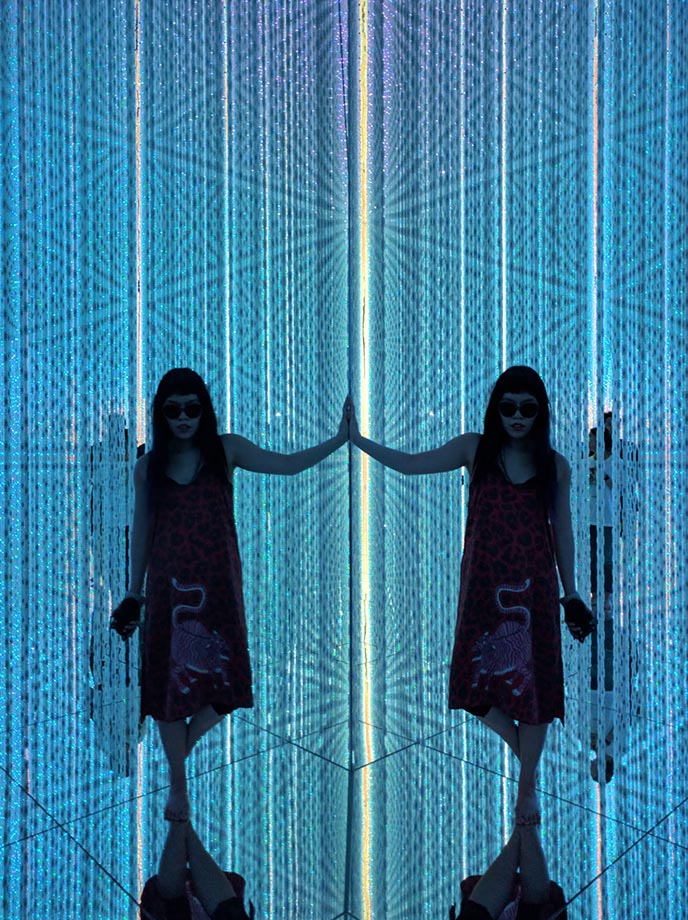
Japan’s teamLab collective dreams up contemporary art exhibitions, with a focus on interactive media. In June 2018, they established a permanent location in Tokyo’s Odaiba.
As you might guess, the Mori Building Digital Art Museum is extremely popular with both locals and travelers. Tickets sell out quickly, so be sure to book passes well in advance from their website.
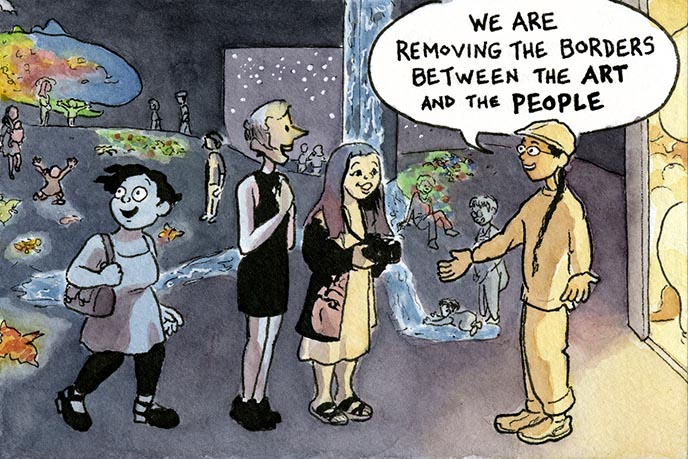
I visited teamLab Borderless with Portland-based artists Becky Hawkins and Naomi Rubin. We were fortunate to have a personal tour with Takashi Kudo, a member of the Digital Arts Collective that created this exhibition.
Becky made this watercolor postcard that perfectly illustrates how mesmerized we were by this digital wonderland.

We walked into a series of rooms with no boundaries, spanning 10,000 square meters. The digital artwork is generally divided into five zones, each transitioning seamlessly into fantastical new worlds.
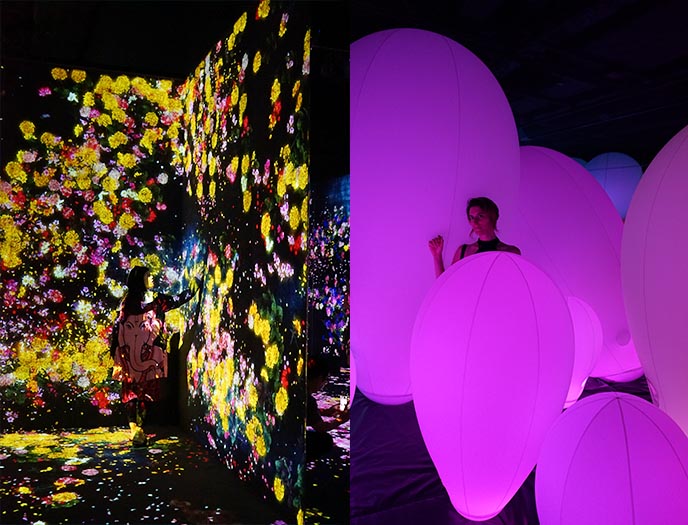
The digital works are in constant motion, and flow over the walls, floors, and ceilings. We were awed by how the art responds to your presence: for instance, the flowers changed pattern and color at my touch.
At traditional museums, the staff puts up barriers and yells “dah-meeee” if you get too close to the art. In contrast, teamLab Borderless invites you to experiment, touch, and play with everything you encounter. Naomi illustrates this by bounding through the balloons (which change color) in the “Weightless Forest of Resonating Life.”
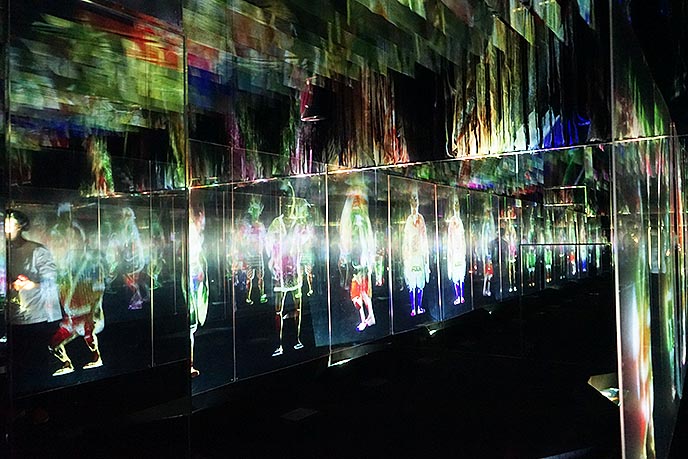
Photos and video don’t do justice to teamLab Borderless. You’ll have to come here yourself, to see how it feels to wander through the ever-morphing exhibits.
This room had rows of glass panels, each with a translucent human or animal figure wearing a Japanese festival outfit. When you stop in front of them, they’ll perform different enka dance moves, and emit various sounds. The music and visuals are therefore constantly changing, depending on the number of people interacting with them.
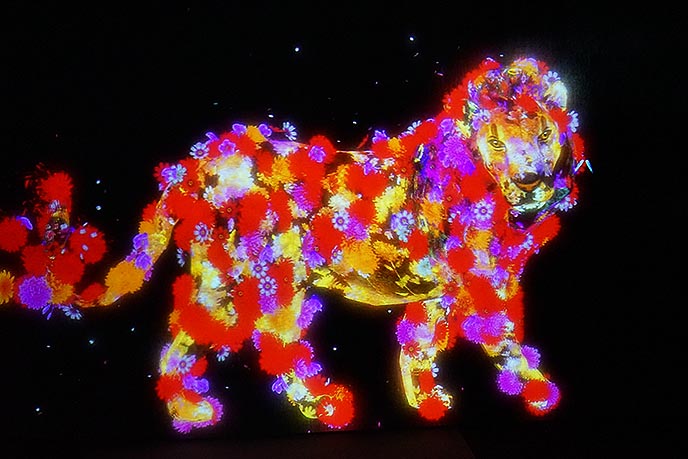
This lion covered in flowers strolled through Borderless World, a zone inspired by nature. Likewise, your presence and actions will affect the way the creatures emote.
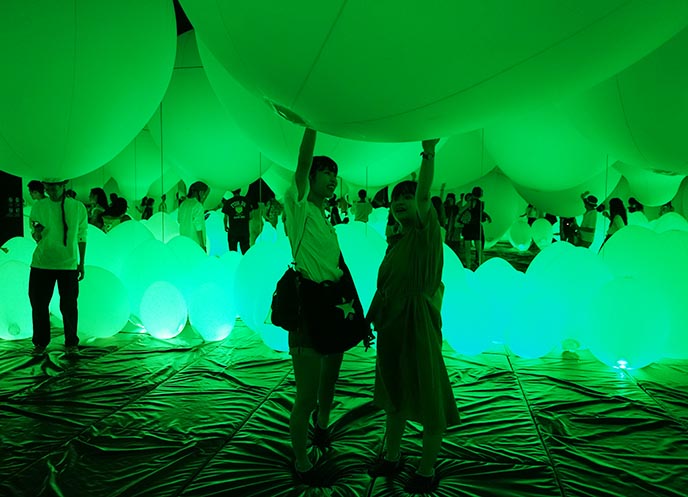
One of the most Instagram-ed areas is the Athletics Forest. It’s as mix of art and PE — you can’t help but run around and explore the physical space.
For more active types, there are even stations for bounding on a trampoline, and climbing through a maze of swings.

Takashi Kudo, our teamLab guide, spoke about how Borderless explores new dimensions of learning. Today, children engage with computers and apps. In the future, how can we keep using technology to learn in new ways?
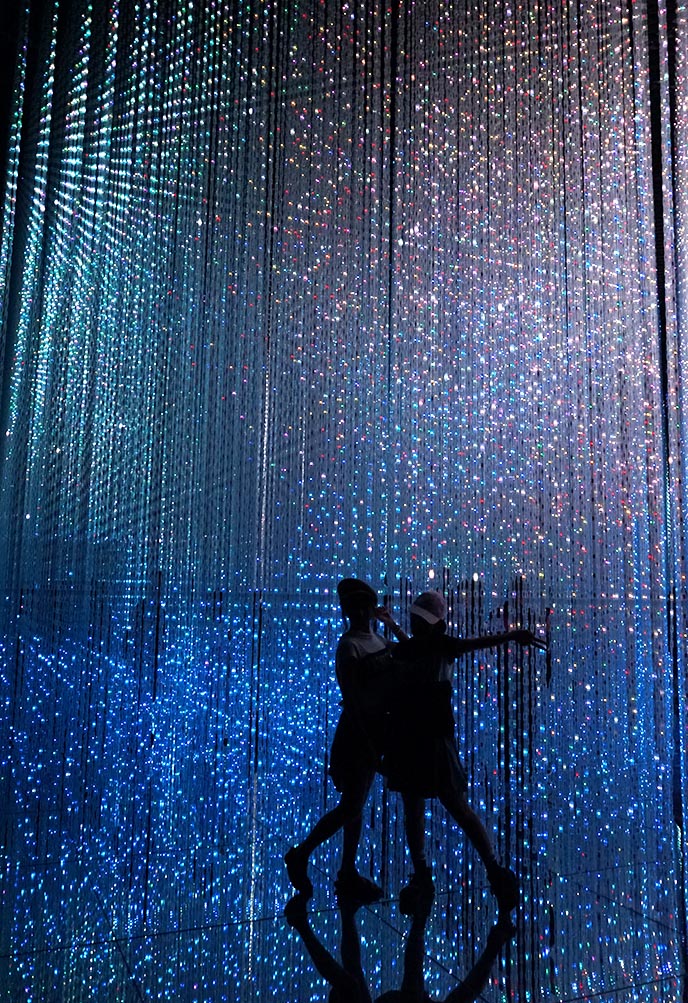
In the “Crystal World,” friends gather to take dynamic silhouettes poses in front of the curtains of sparkling lights.

Another room featured dancing strobes of light set to sound, much like a sci-fi movie or EDM party.
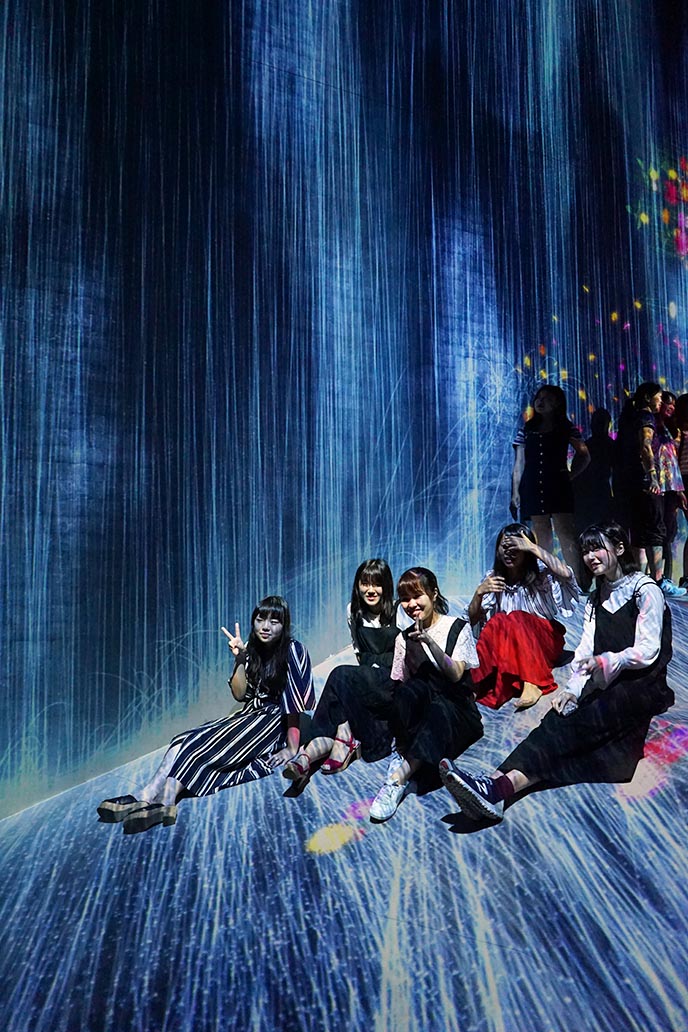
It’s remarkable that these enormous, evocative displays — like this “waterfall” — are made with digital art and sound effects.

Artist Becky Hawkins created a watercolor travel postcard that shows a scene from our tour. “Every few centuries, there’s a revolution that brings about a new way of seeing. The internet is the latest such revolution.
How does our relationship to images change when they can be shared instantly, across the world? We don’t know yet!”
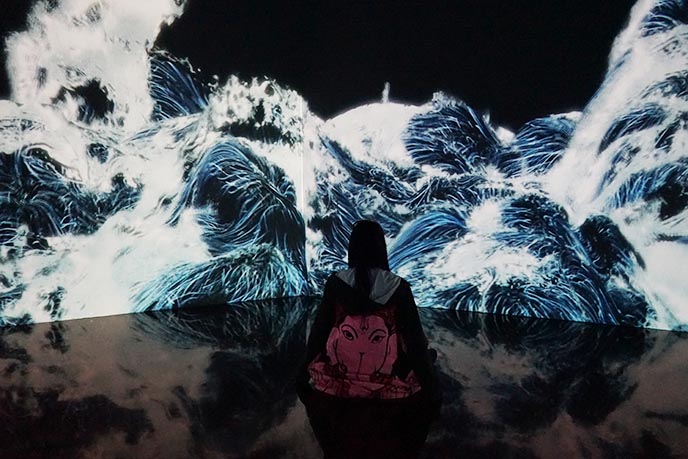
“This room was inspired by Hokusai’s “Great Wave,” We celebrate Japan’s past while we look to the future.”
Takashi told us about Japanese monks who sat by the ocean for decades, meditating. This space encourages you to do the same, in front of the shifting digital waves.
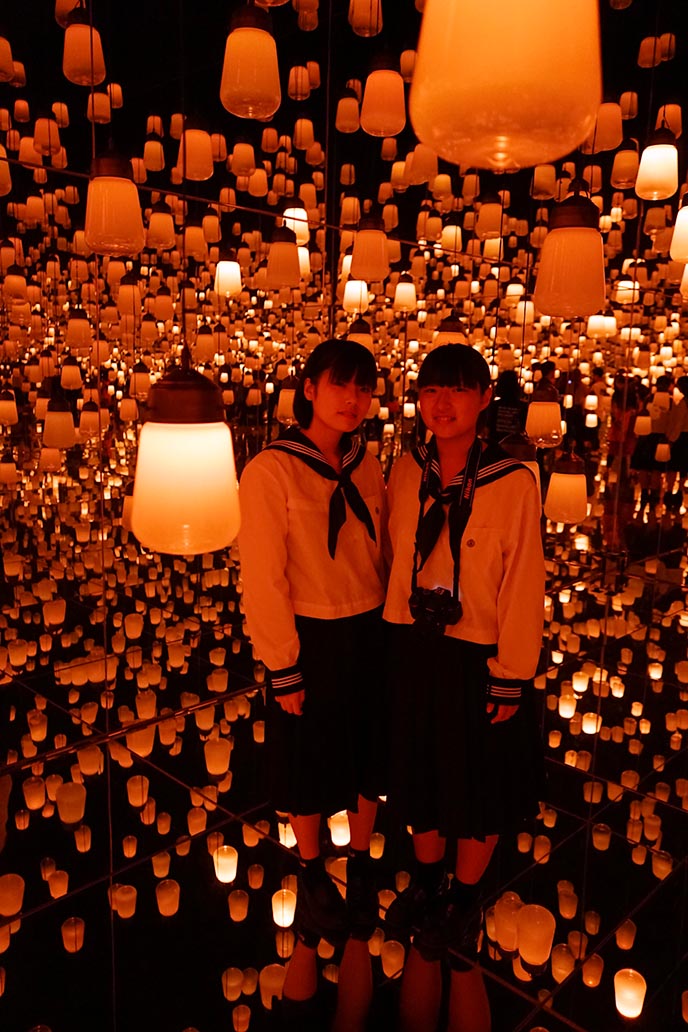
The Forest of Lamps allows only a limited number of people inside at one time, so there may be a line up for this popular exhibit. When you approach a lantern, it responds by emitting light that spreads to nearby lamps.

Becky Hawkins bugs out at Naomi’s insightful connection between the forest and ocean zones.
“‘The Wave’ is a really good parallel, actually, because woodblock printing was another technology that enabled an image to be reproduced and shared on a previously unimaginable scale…”
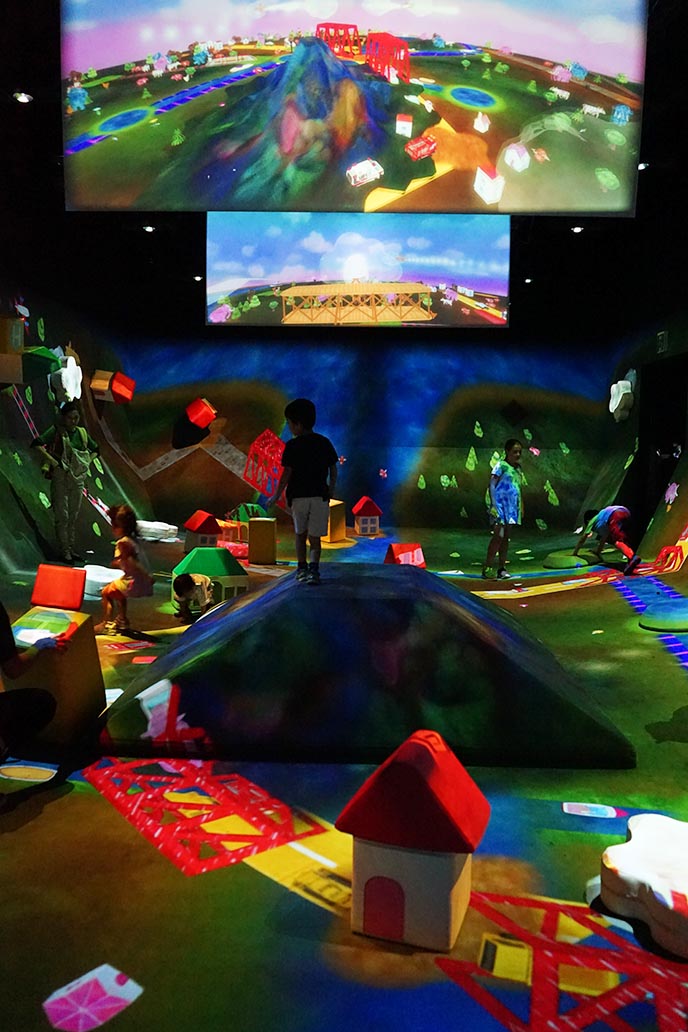
We peeked into this room designed for children. The screen shows a bird’s eye view of a city, which mirrors the layout of the room.
Anyone can add bridges, homes, and other movable objects to the urban design — which immediately changes what you see on the screen!
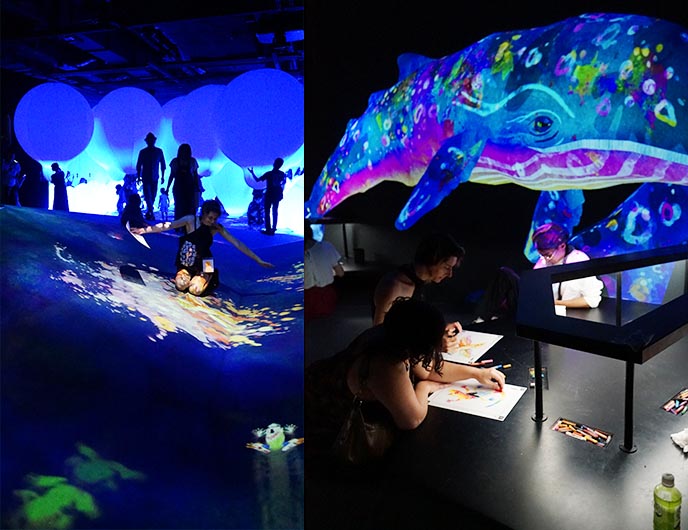
“Future Park” is another educational experience that merges art and technology. The “Sketch Aquarium” lets you add color to outlines of ocean creatures.
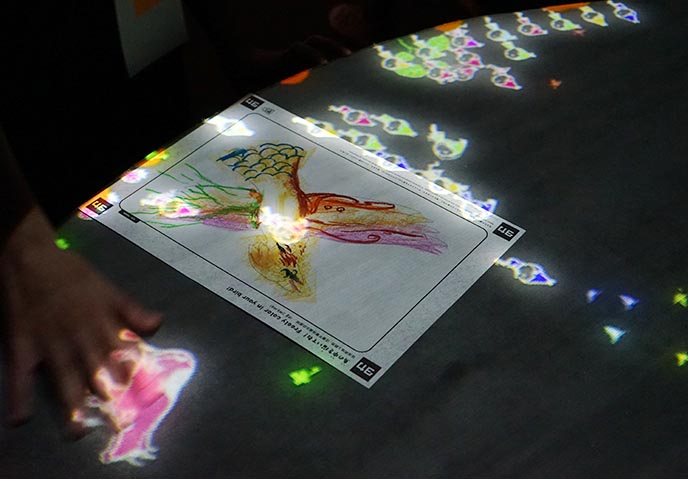
Then, you pass the page through a digital scanner. The creature comes to life as an animated digital image that moves through the exhibit.
Naomi colored in this phoenix, and once she scanned it, the bird flew over the mountains and valleys of the park.
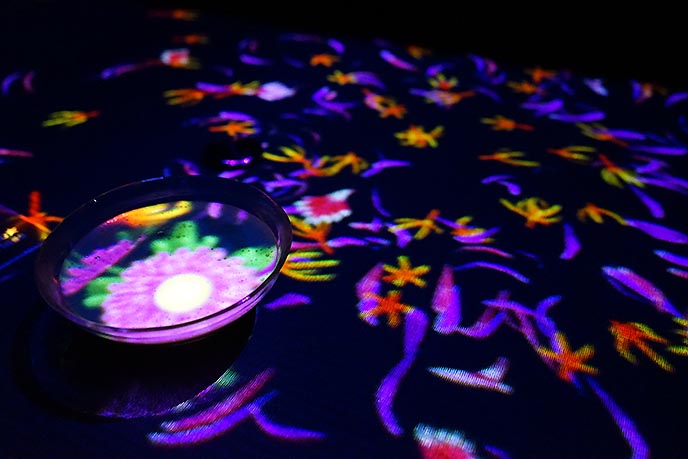
Don’t leave before a cup of matcha (powdered green tea) at the museum’s EN Tea House. In this unusual cafe, you sit on long benches in a dark tearoom.
When the server pours tea into your glass bowl, it lights up with floral patterns. When you sip the tea, neon flowers bloom and petals float out to the table and walls!
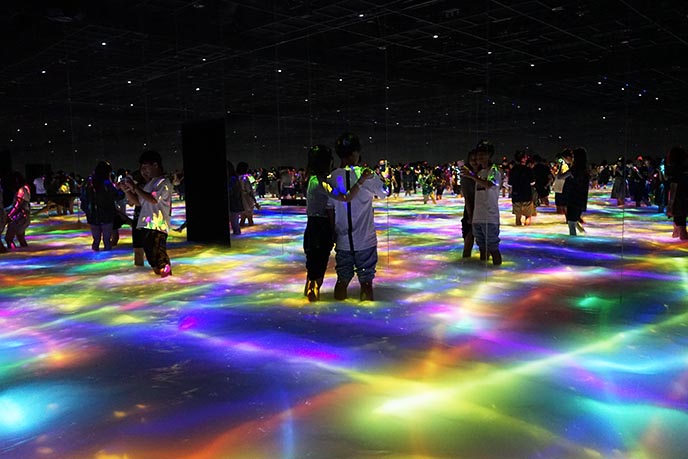
Takashi Kudo then took us to visit teamLab Planets Tokyo — a temporary museum by the same collective, located next to Shin-Toyosu Station. (It requires a separate ticket, which you should also book well ahead of time.) These virtual installations are more intimate, and play with themes of new worlds.
When you enter, you must take off your shoes and walk up a ramp streaming with water! You’ll explore the entire museum barefoot, including parts where you wade through a glowing pond of water.
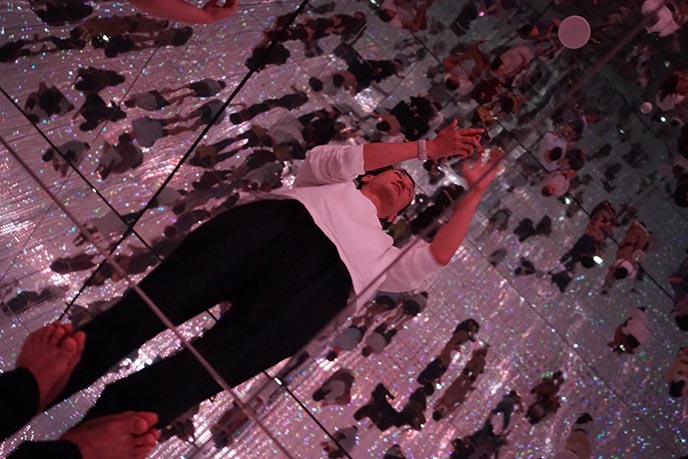
One of the “dimensions,” called the Infinite Crystal Universe, was surrounded by mirrors on all floors and ceilings. Here, Takashi is showing how anyone can use a special app to change the light and sound patterns in this room.
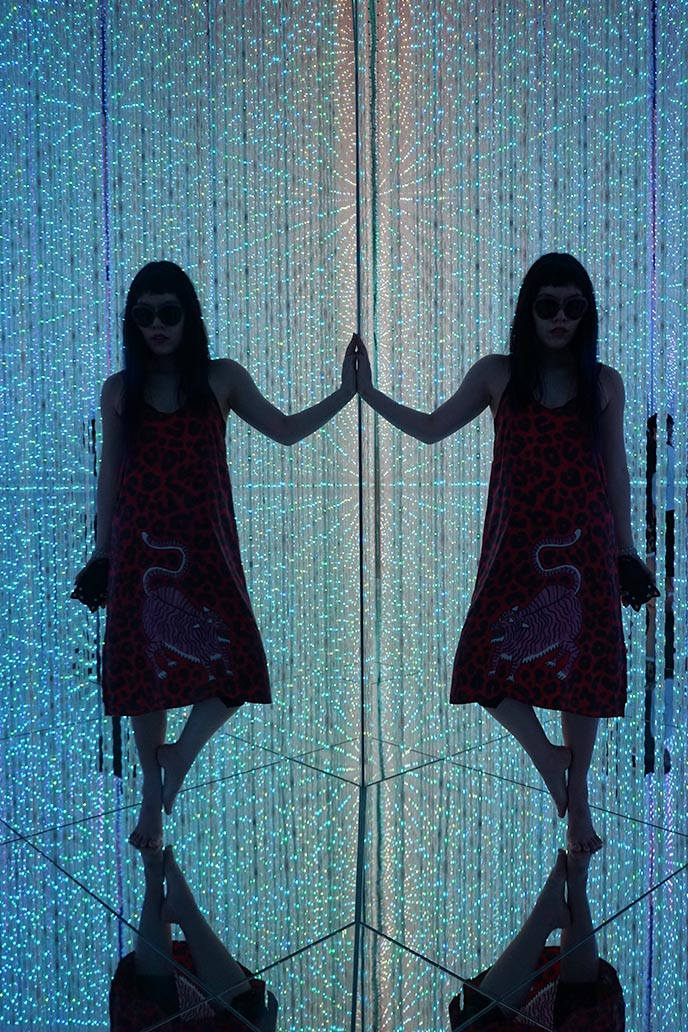
When you look around, you see yourself mirrored to infinity — a trippy feeling, especially amidst these glistening strands of lights.
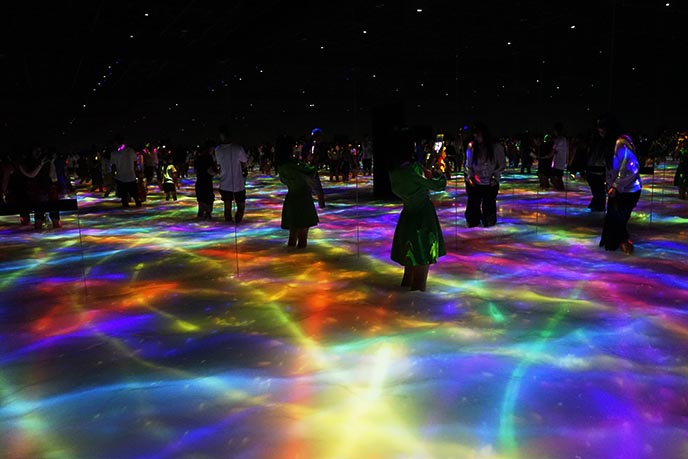
I’ve never visited any art installation like this one, called “Drawing on the water surface created by the dance of koi and people – Infinity.” You wander through a calf-high ocean that is filled with virtual fish and lights.
When you touch one of the goldfish, it bursts into flowers and floats through the water. The visuals are constantly in flux, as each interaction changes how the space looks.

teamLab Planets ends on a beautiful note, with the “Falling universe of flowers.” Lie down, and watch flowers drift throughout the room — blossoming, changing, and dying with the seasons. The floral free-fall evolves in real-time, depending on how you respond to the installation.
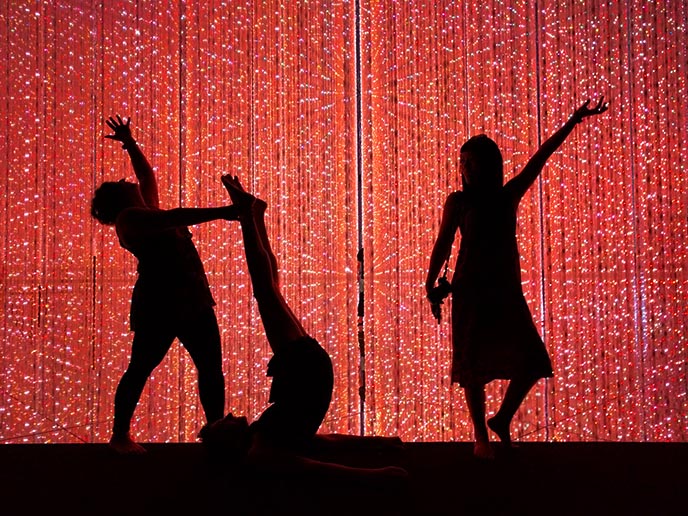
teamLab Planets and Borderless (Mori Digitual Art Museum) are powerful, immersive spaces that merge the boundaries between the viewer and works. Above all — they encourage you to activate your imagination, and have fun with friends! If you are heading to Tokyo, book teamLab tickets as soon as you can, as you don’t want to miss out.
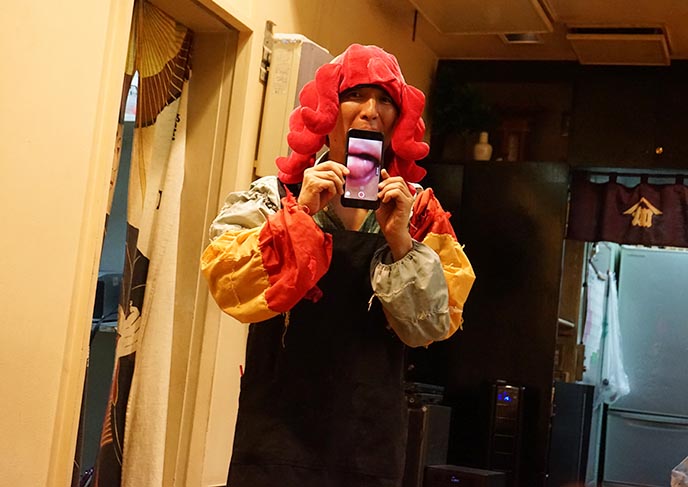
We ended our Tokyo trip with another type of interactive art… Kagaya, our favorite izakaya restaurant! Long-time readers of this blog will know that we always come back to see Mark and his zany performances.

I’ve been to Kagaya at least 6 times now, and his surreal, head-scratching, hilarious antics never get old. Will the teddy bear manage to carry the heavy tray to Trevor, or will he buckle under the weight? We cheered, “You can do it, bear!”
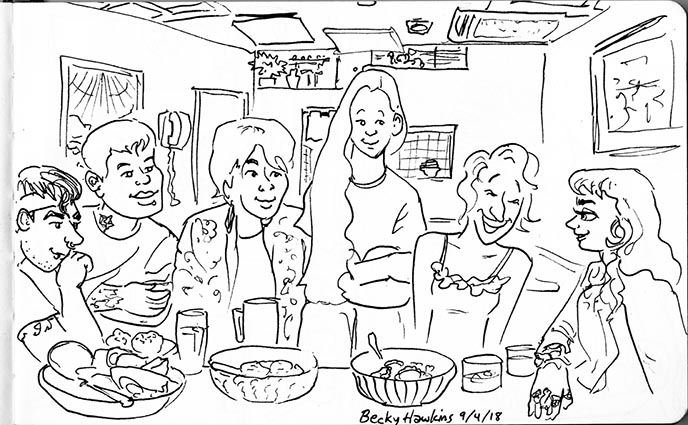
Becky Hawkins made this illustration of our joyful group dinner. Kagaya serves wonderful traditional Japanese food, including mackerel, all types of tofu, kabocha (pumpkin), and sake.

Whenever you order a drink, you get to choose the name of a country from a list on the menu. “Normal Mark” ducks into the closet …. and comes out as a wild character!
I don’t want to ruin the surprise, but you have to trust us: Kagaya is a true gem, and the site of some of my fondest memories in Tokyo. You can reserve at table and find the map to Kagaya here.

There’s no doubt I will be back in Asia soon, to bring more crazy tales to you! I want to visit the new permanent Sailor Moon cafe in Tokyo when it opens… I also have some comprehensive Japanese travel guides coming out on another website, so keep your eyes peeled.
PS – if you’re hungry for more Tokyo tips, I have over 10 years (!!) of subculture coverage on La Carmina blog. You can find everything in my Japan travel section.

 LA CARMINA
LA CARMINA






